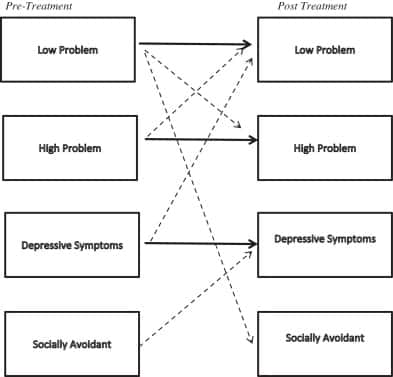In social anxiety disorder co-morbid depressive symptoms as well as avoidance behaviors have been shown to predict insufficient treatment response. It is likely that subgroups of individuals with different profiles of risk factors for poor treatment response exist. We examined this in a new study that was just published in Journal of Anxiety Disorders entiled “Risk profiles for poor treatment response to internet-delivered CBT in people with social anxiety disorder“.
Our study aimed to identify subgroups of social avoidance and depressive symptoms in a clinical sample (N = 167) with social anxiety disorder before and after guided internet-delivered CBT, and to compare these groups on diagnostic status and social anxiety. We further examined individual movement between subgroups over time. Using cluster analysis we identified four subgroups, including a high-problem cluster at both time-points. Individuals in this cluster showed less remission after treatment, exhibited higher levels of social anxiety at both assessments, and typically remained in the high-problem cluster after treatment. Thus, in individuals with social anxiety disorder , high levels of social avoidance and depressive symptoms constitute a risk profile for poor treatment response.
Read the full paper:
Tillfors, M., Furmark, T., Carlbring, P., & Andersson, G. (2015). Risk profiles for poor treatment response to internet-delivered CBT in people with social anxiety disorder. Journal of Anxiety Disorders, 33, 103-109. doi: 10.1016/j.janxdis.2015.05.007
